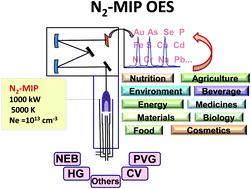当前位置:
X-MOL 学术
›
J. Anal. At. Spectrom.
›
论文详情
Our official English website, www.x-mol.net, welcomes your
feedback! (Note: you will need to create a separate account there.)
Advances of nitrogen microwave plasma for optical emission spectrometry and applications in elemental analysis: a review
Journal of Analytical Atomic Spectrometry ( IF 3.1 ) Pub Date : 2020-08-13 , DOI: 10.1039/d0ja00272k Alexandre Müller 1, 2, 3, 4 , Dirce Pozebon 1, 2, 3, 4 , Valderi L. Dressler 4, 5, 6, 7
Journal of Analytical Atomic Spectrometry ( IF 3.1 ) Pub Date : 2020-08-13 , DOI: 10.1039/d0ja00272k Alexandre Müller 1, 2, 3, 4 , Dirce Pozebon 1, 2, 3, 4 , Valderi L. Dressler 4, 5, 6, 7
Affiliation

|
The present review deals with microwave-induced plasma optical emission spectrometry (MIP OES) with focus on MIP sustained by N2. Advances of MIP OES as an analytical tool and N2-MIP OES application in elemental analysis are highlighted. The novel microwave inductively coupled atmospheric-pressure plasma (MICAP) is also presented and the N2-MICAP is discussed. The assertion of MIP OES as an atomic spectrometry technique for elemental analysis occurred mainly due to the development of N2-MIP generated in a cavity embedded in a narrow width waveguide. The precise location of the cavity as a function of the wavelength associated with the 2450 MHz frequency maximizes the magnetic field and generates H-type excitation almost entirely, and is similar to that occurring in argon inductively coupled plasma (Ar-ICP). Microwave induced plasma optical emission spectrometry based on the use of N2-MIP is in general more sensitive in terms of detection limit than the flame atomic absorption spectrometry (FAAS) and almost comparable to inductively coupled plasma optical emission spectrometry (ICP OES). Since the introduction of a commercial N2-MIP OES instrument in the last decade, which allows metals and non-metal determination, applications of the technique for the analysis of samples with different matrices have increased as demonstrated in the present review.
中文翻译:

氮微波等离子体在光发射光谱中的应用及其在元素分析中的应用
本综述涉及微波诱导等离子体发射光谱法(MIP OES),重点是由N 2维持的MIP 。重点介绍了MIP OES作为分析工具的进展以及N 2 -MIP OES在元素分析中的应用。还提出了新颖的微波感应耦合大气压等离子体(MICAP),并讨论了N 2 -MICAP。MIP OES作为元素分析的原子光谱技术的主张主要是由于N 2的发展-MIP在嵌入窄宽度波导的空腔中生成。腔的精确位置是与2450 MHz频率相关的波长的函数,它使磁场最大化并几乎完全产生H型激发,这与在氩气感应耦合等离子体(Ar-ICP)中发生的情况相似。基于N 2 -MIP的使用的微波感应等离子体发射光谱通常在检测极限方面比火焰原子吸收光谱法(FAAS)更灵敏,并且几乎可与电感耦合等离子体发射光谱法(ICP OES)相比。自从引入商业N 2-在过去的十年中,MIP OES仪器可用于金属和非金属的测定,该技术在分析具有不同基质的样品中的应用有所增加,如本综述所述。
更新日期:2020-10-11
中文翻译:

氮微波等离子体在光发射光谱中的应用及其在元素分析中的应用
本综述涉及微波诱导等离子体发射光谱法(MIP OES),重点是由N 2维持的MIP 。重点介绍了MIP OES作为分析工具的进展以及N 2 -MIP OES在元素分析中的应用。还提出了新颖的微波感应耦合大气压等离子体(MICAP),并讨论了N 2 -MICAP。MIP OES作为元素分析的原子光谱技术的主张主要是由于N 2的发展-MIP在嵌入窄宽度波导的空腔中生成。腔的精确位置是与2450 MHz频率相关的波长的函数,它使磁场最大化并几乎完全产生H型激发,这与在氩气感应耦合等离子体(Ar-ICP)中发生的情况相似。基于N 2 -MIP的使用的微波感应等离子体发射光谱通常在检测极限方面比火焰原子吸收光谱法(FAAS)更灵敏,并且几乎可与电感耦合等离子体发射光谱法(ICP OES)相比。自从引入商业N 2-在过去的十年中,MIP OES仪器可用于金属和非金属的测定,该技术在分析具有不同基质的样品中的应用有所增加,如本综述所述。











































 京公网安备 11010802027423号
京公网安备 11010802027423号